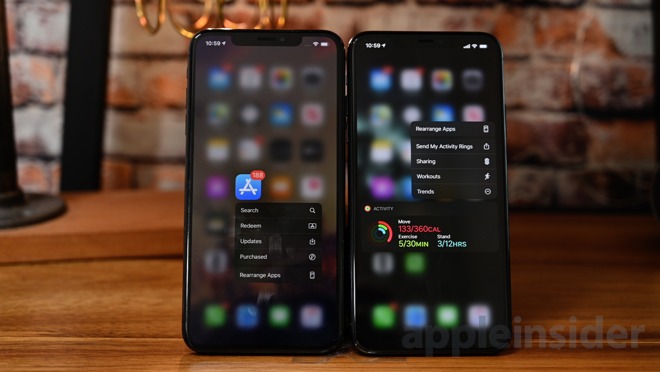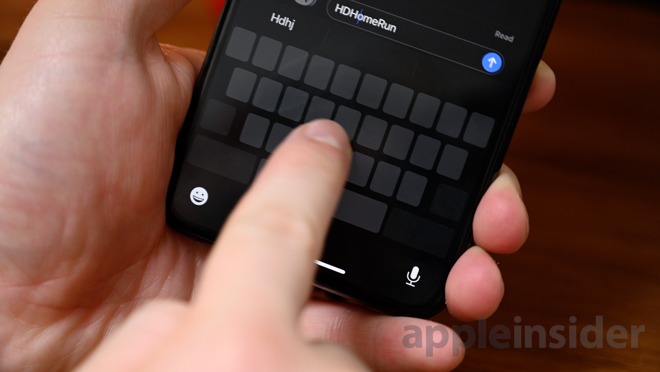Editorial: Apple's removal of 3D Touch is a backwards step for 'Pro' iPhones
Apple's iPhone 11 Pro and iPhone 11 Pro Max are exceptional new devices, packed full of new features. While there is much to like on the new phones, the absence of 3D Touch is a step backwards.

3D Touch versus Haptic Touch
Not everyone used it, but 3D Touch brought the iPhone a whole new level of fast interactivity -- and now we've lost it.
Instead, the new iPhone 11, iPhone 11 Pro and iPhone 11 Pro Max all used the cheaper alternative that Apple introduced with the iPhone XR. Instead of an actual pressure-sensitive display, we get what Apple calls Haptic Touch.
This is the iPhone-maker's attempt to replicate the physical pressure-sensing display purely in software. While it has a fancy name, it isn't much more than a long press that triggers some feedback from the Taptic Engine.
It's portrayed as an enhancement for iOS 13, but even if you think that, it still means Apple felt it could ditch the more costly physical display 3D Touch required.
Unfortunately, as those who have used 3D Touch for a long time can attest, Haptic Touch simply isn't a good enough replacement for 3D Touch. The difference is small -- but it isn't slight -- and it mars the otherwise excellent iPhone 11 Pro experience.
It does these things that we've come to like, yet in every case it does them worse than it did with 3D Touch.

Rearranging app icons is less intuitive with Haptic Touch
Take rearranging icons. Before it took a long hold to enter "jiggle mode" and a force press to open up the 3D Touch contextual menu. Without 3D Touch, you have to long hold to open the menu, and hold even longer to rearrange (or use the Rearrange Apps button in the menu).
On the Lock Screen, it now takes even longer to deliberately open the flashlight or access the camera -- frustrating on a phone that is overall faster thanks to the A13 Bionic processor.

Toggling the flashlight on accident is more common with Haptic Touch
Frustratingly, the same feature means it's actually quick to turn on the camera or flashlight accidentally. As we pull the phone out of our pocket, the screen comes on, our finger happens to be in one of the corners, and so the light or camera start.
With 3D Touch, it required a purposeful press instead of just an elongated period of time.
Inside of Messages, we also weren't able to preview links that were sent. A long press in Messages means you want to use the Tapback feature, or copy the link. 3D Touch allowed us to long press for those features, but forcefully press for a link preview via Peek and even harder to open it via Pop.

Moving the cursor is easier with 3D Touch
On the keyboard, users could use 3D Touch to forcefully press anywhere on the keyboard to move the cursor around. With Haptic Touch, you must instead press and hold on the space bar. It isn't as intuitive, you're never going to find it by chance, and it is slower.

Camera is now slower on iPhone 11 Pro Max because of Haptic Touch
Unfortunately, for Apple's flagship phones, it is a huge step backwards. Directly compared to 3D Touch on the iPhone XS Max, Haptic Touch is slower, it is more frustrating, it is less user-friendly, and is simply a progression in the wrong way.
Apple's software ability is legendary, and we wouldn't doubt that there will be iterations and improvements to Haptic Touch, but without that physical pressure-sensitive screen, it will never be able to fully replicate what 3D Touch was capable of.
Despite this arguably being a Pro feature, the hardware required to do it has been stripped from Apple's new Pro phones. It's gone for good, and it isn't coming back.

3D Touch versus Haptic Touch
Not everyone used it, but 3D Touch brought the iPhone a whole new level of fast interactivity -- and now we've lost it.
Instead, the new iPhone 11, iPhone 11 Pro and iPhone 11 Pro Max all used the cheaper alternative that Apple introduced with the iPhone XR. Instead of an actual pressure-sensitive display, we get what Apple calls Haptic Touch.
This is the iPhone-maker's attempt to replicate the physical pressure-sensing display purely in software. While it has a fancy name, it isn't much more than a long press that triggers some feedback from the Taptic Engine.
It's portrayed as an enhancement for iOS 13, but even if you think that, it still means Apple felt it could ditch the more costly physical display 3D Touch required.
Unfortunately, as those who have used 3D Touch for a long time can attest, Haptic Touch simply isn't a good enough replacement for 3D Touch. The difference is small -- but it isn't slight -- and it mars the otherwise excellent iPhone 11 Pro experience.
Where it falls short
Haptic Touch does a decent job throughout the OS mimicking pressure sensitivity. It can preview emails, move the cursor, rearrange icons, open the camera from the Lock Screen.It does these things that we've come to like, yet in every case it does them worse than it did with 3D Touch.

Rearranging app icons is less intuitive with Haptic Touch
Take rearranging icons. Before it took a long hold to enter "jiggle mode" and a force press to open up the 3D Touch contextual menu. Without 3D Touch, you have to long hold to open the menu, and hold even longer to rearrange (or use the Rearrange Apps button in the menu).
On the Lock Screen, it now takes even longer to deliberately open the flashlight or access the camera -- frustrating on a phone that is overall faster thanks to the A13 Bionic processor.

Toggling the flashlight on accident is more common with Haptic Touch
Frustratingly, the same feature means it's actually quick to turn on the camera or flashlight accidentally. As we pull the phone out of our pocket, the screen comes on, our finger happens to be in one of the corners, and so the light or camera start.
With 3D Touch, it required a purposeful press instead of just an elongated period of time.
Inside of Messages, we also weren't able to preview links that were sent. A long press in Messages means you want to use the Tapback feature, or copy the link. 3D Touch allowed us to long press for those features, but forcefully press for a link preview via Peek and even harder to open it via Pop.

Moving the cursor is easier with 3D Touch
On the keyboard, users could use 3D Touch to forcefully press anywhere on the keyboard to move the cursor around. With Haptic Touch, you must instead press and hold on the space bar. It isn't as intuitive, you're never going to find it by chance, and it is slower.
No future
On the iPhone XR, Haptic Touch was a fantastic replacement for 3D Touch that meant Apple could make a more affordable phone. On the iPad, too, it brought us features that had been previously limited to iPhone.
Camera is now slower on iPhone 11 Pro Max because of Haptic Touch
Unfortunately, for Apple's flagship phones, it is a huge step backwards. Directly compared to 3D Touch on the iPhone XS Max, Haptic Touch is slower, it is more frustrating, it is less user-friendly, and is simply a progression in the wrong way.
Apple's software ability is legendary, and we wouldn't doubt that there will be iterations and improvements to Haptic Touch, but without that physical pressure-sensitive screen, it will never be able to fully replicate what 3D Touch was capable of.
Despite this arguably being a Pro feature, the hardware required to do it has been stripped from Apple's new Pro phones. It's gone for good, and it isn't coming back.




Comments
I'm disappointed that it's gone. I see it as a contextual menu that can be different for every app (that used it) and the complaints of non-uniformity didn't change my think.
RIP, 3D. I hardly knew ya.
1. As much as I loved it, VERY FEW people used it. Discovery of allowed shortcuts was crap, and the experience was inconsistent. A smallish group of pro / hardcore users loved the feature like I did, but it was hardly a top 10 feature for the masses.
2. Removing the 3D touch components created a TON of space inside iPhones to expand the battery. Those extra 4-5 hours come from a more efficient processor, AND a bigger battery.
I guess, given the hard choice, I would choose longer battery life and haptic touch over the alternative. I still miss 3D touch, particularly with Peek / Pop and in the keyboard.
Removing features after the purchase isn't something that users tend to take lightly, see Nest and the camera notification light for example.
Though I do prefer the long press for rearranging app icons vs. the display of a context menu. I mean when does anyone ever rename an icon, a group yes but I only do that when I create a group and the normal method of opening it and then editing the caption is fine. Apple we don't need it in a context menu and we don't need a done button either.
The only feature that I truly liked and ever used was to position the cursor while editing text vs. trying to tap in a small textbox with my finger and hope the cursor would land where I needed it to. So thank you for the article b/c I didn't know about pressing over the space bar. Works great.
Seems like a logical compromise to me. Trade in a feature that very few developers and even fewer people used in exchange for giant upgrades to the two features nearly every survey says are the most important things people consider when purchasing new phones.